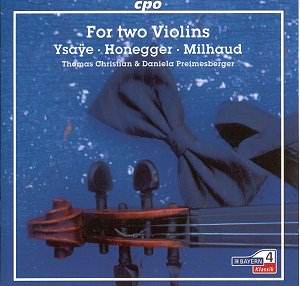The Ysaÿe is quite
a remarkable work. Each piece on this
disc is given a fanciful subtitle by
the booklet-note writer, Hans Winking.
For this work, he comes up with, 'Symphonic
Virtuosity on Eight Strings' and listening
to the Sonata it is easy to see what
he means. There are three movements
(11'52 + 7'58 + 14'01). Textures can
be astonishingly rich, something Christan
and Priemesberger seem to relish. The
recording is big-boned, too, and the
duo's performance realises the composer's
rhetoric exactly while still revealing
myriad detailing. Phrasing can be pointed
and even delightful ľ overall this is
superbly interesting music, realised
with the utmost confidence.
The gentle opening
of the middle 'Allegretto poco lento'
does become more resolute later. The
final dying away is excellently graded,
leading to the serious and concentrated
finale - not to mention difficult. It
is difficult for the listener, too,
but brings with it rich rewards. Superb
virtuosity from both players here.
Two works by Milhaud
('Or, the Terror of the Groupe des Six'
ľ Winking) essentially mean twice the
treat. The Duo opens with a characteristic
touch of acidity, soon threatening towards
bitonality - but not actually truly
getting there. The melancholy slow movement
(a Romance) blossoms into real warmth,
leading to a playful Gigue. The Sonatine
was written on an overnight train journey
(October 13th-14th,
1940)! The delicate, light opening movement
reveals the telepathy between Christian
and Priemesberger. Delicacy is once
more the order of the day (or night,
thinking about it) for the expressive
Barcarolle with its nice use of pizzicato
before the dancing and vital Rondo finale.
Finally, some Honegger
('or, The Tradition as Avant-Garde'),
whose first movement provides moments
of real delight and rises to an impressive
close. Best of all, though, is the ghostly,
almost whispered Andantino. The slithery
imitations of the finale have a lot
going for them, though. This work is,
appropriately in this context, dedicated
to Milhaud.
To be entirely frank
I wasn't sure I'd enjoy an entire disc
of music for two violins. I was grinning
by the end of it. Wholeheartedly recommended.
Colin Clarke


